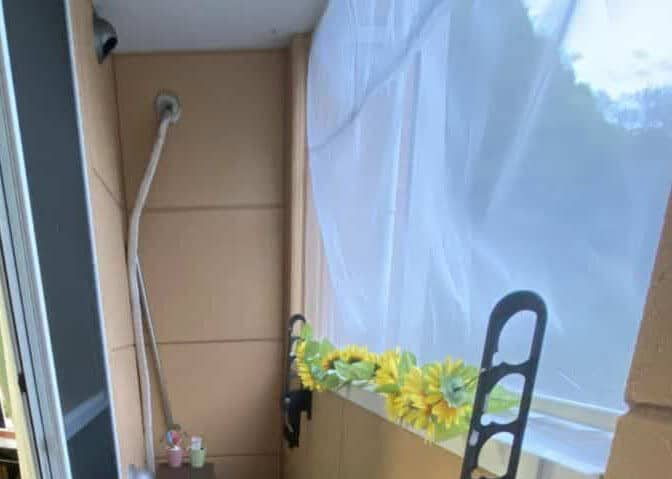When you have a balcony, you want to be able to enjoy it. The most common need for a screened-in balcony is to avoid the bugs. Perhaps you’ve asked yourself how you can screen in your balcony?
Screening in a balcony is similar to screening a porch. You want to first measure the materials needed, choose the type of screen you want, add the base strips, attach the screen, and finally, attach the cap strips. There are also moveable options available, and different methods you could try.
Let’s take a closer look at each step and the best ways to do them.
1. Measure Your Materials
The first thing you want to do when screening in your balcony is to measure all of the materials you’re going to need to use. While other methods don’t require a frame (see stapling below), using a frame or a screening kit will make it easier to replace damaged screens. It also produces a cleaner finished product than some other methods.
Measure the vertical and horizontal spaces that will be screened in. This will calculate how much framing material you’ll need. To find out how much screen you’ll need, multiply the height and width of the balcony. Once you have that, add an additional 10% of that number to account for any waste.
2. Choose a Screen Type
Choosing the screen mesh that you’ll use on your balcony is the next step. It’s important to get a screen that will work for your environment. If you have pets that could damage the screen, selecting one that is pet-resistant will be necessary.
Most screen frames come in any size, so you should pick rolls of screen mesh that fits close to your particular frame. They typically come in rolls of 3 ft (0.9 m) or 8 ft (2.4 m) widths.

Fiberglass mesh (link to Amazon) is the most common screen option. It’s easy to work with because of how flexible it is. However, it’s more prone to damage because it can stretch and tear.
Metal screens are typically made from aluminum and are much more durable. The issue here is that they’re much less flexible and require more work when installing them.
3. Add the Base Strips
You’re going to add these base strips to the wood frame that is already there, or that you made yourself. The base strips can be cut to fit any size frame that you’re working with. You’ll cut the strip using tin snips or a similar tool.
Fit the strip to the frame and screw it into the wood using 1-inch wood screws. You can use a drill with the proper screwdriver head attached to ensure the screws are tightly installed.
However, you’ll want to make sure you don’t over tighten the screws. This can damage and warp the strips, which will affect how the screen fits.
4. Attach the Screen
One of the most effective ways to attach screen mesh to base strips is by using a screen spline. This is a rubber material that is designed to fit snug in the strips, securing the screen mesh with it.
To attach the spline, you’ll need a rolling tool to make it easy. To get started, you’ll want to cut your screen just a little larger than the space you intend to use it in. Once your screen is ready, place the mesh under the rubber spline and roll it into the base strips.
Use the roller to press the rubber spline into the strip while you pull on the screen mesh to keep it tight. Use a utility knife to cut away the excess mesh, then repeat as needed until the screen is tightly secured to the frame.
Keep in mind: a fiberglass screen requires a rubber spline that’s 0.175 in (0.445 cm) in diameter, while a metal screen requires 0.160 in (0.407 cm) in diameter.
5. Attach Cap Strips
Attaching cap strips is an optional step, but it really makes the area look nice and polished. Cap strips are simply pieces that go over the base strips to cover them.
You’ll attach them using a rubber mallet. If repairs need to be made, cap strips can be removed by using a screwdriver. Just be careful not to damage them.
Alternate Methods to Consider
If you’re a renter, it’s likely you aren’t able to install a permanent structure such as a frame. Balconies also come in a variety of spaces and sizes, which make installing wood frames difficult. That’s okay, though, because there are plenty of other options that could work for you too.
6. Magnetic Screening
Metal strips and strong magnets could be a reasonable option for you if you can’t install a frame. This works with both metal and fiberglass screening. However, magnets won’t work on aluminum screens.
You’ll want to place the metal strips to all of the beams and boards that make up the perimeter of the balcony. Put the screen up to the metal and then place the magnet on top of the screen. You can then trim the excess screening away with a utility knife or scissors.
This is also a great option because you can easily remove the screening if you need to. It also makes repairs quick and simple.
7. Stick-On Method
This method will require a bit more work on your own, as opposed to the magnetic screening mentioned above.
Mosquito netting (link to Amazon) can be a great alternative to traditional screening. Using this method, you’ll need to prepare the netting before installing it. You’ll want to cut it to the size you need first. Once that is finished, you’ll use hook and loop strips (sometimes called Velcro) to attach it to the balcony’s perimeter.
You’ll put the sticky-backed side of the Velcro strips to the borders of your balcony where the netting needs to go. Once you have that in place, sew on the soft side of the Velcro to the netting. You’ll want to use a thick and durable thread, such as an upholstery thread or fishing line.
Once your Velcro is attached to the netting, you can place it on the hook side of your balcony’s walls or ceilings. This is another easily removable method that makes repairs simple as well.
8. Stapling
If you want to screen in your balcony quickly, you can go with the simple stapling method. This is a quick fix that works especially well with fiberglass screening due to its flexible nature.
You’ll still need a frame to staple the screening to. The first thing to do is cut the screening to fit your area, remembering to add 10% for waste.
Next, hold one edge up to the framing, and staple it into the wood. Continue doing this until the area is finished. Make sure you keep the screening taut as you work.
9. Types of Moveable Screens
Sometimes being able to open the screens is needed. Whether it’s for an emergency or simply because you want them open, having a moveable screen is often more desirable than just enclosing a balcony. Below is a list of a few options you could try:
- Roll Up Screens – These are screens attached to the overhang of your balcony and are dropped down when a barrier is needed.
- Sliding Screens – This method involves installing a permanent railing and track system onto your balcony. It will add versatility to your balcony and works similarly to the window of your home.
- Curtain Screen – A curtain screen is installed similarly as roll-up screens. It attaches to an overhang or wall of the balcony and usually has an opening cut into the middle of it. It can be rolled up or to the side if desired.
Summary
A balcony can be a beautiful oasis and a special retreat. A screened-in balcony provides additional protection from bugs and other pests. Hopefully, this step-by-step guide for how to screen in a balcony has been helpful for yours.

